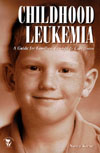Childhood Leukemia : A Guide for Families, Friends & Caregivers
encontrar mi
Author: Nancy Keene |
Nancy Keene's daughter survived childhood leukemia, which motivated this fledgling author to write this book. She felt the need to be an informed parent as her daughter underwent treatment, but found it a daunting and exhausting task to research leukemia in the face of such stress. She thus wrote a comprehensive guide, compiling information gathered from her personal experience, interviews with over forty families of children with leukemia, and the latest medical information. Much of the book is told through the direct quotes of the people whom she interviewed. Keene writes: "I have organized the book sequentially in an attempt to parallel most families' journey through treatment." The book journeys from diagnosis, learning about leukemia and the medical procedures, to dealing with families and friends, and continuing schooling and education for the ill child.
The first chapters discuss the medical and scientific information one needs to know when one's child has been diagnosed with leukemia. Issues such as diagnosis, procedures, clinical trials, and defining the different types of leukemia are covered. The book does an excellent job in defining and explaining medical terminology in layperson's terms. The author is not a physician, and these chapters are not very in-depth, but she provides lists of resources one can turn to for more information. She actually provides a list of suggested readings and helpful addresses for both adults and children at the end of every chapter.
The next chapters discuss more emotional issues that arise after one's child has been diagnosed. How to deal with families and friends, how to effectively interact with the medical team, and how to adjust to life in the hospital are issues that are covered. The book covers sensitive issues such as how to tell your child, taking into account the fact that different age groups tend to respond to such news in different manners. It also addresses how to talk to siblings and other family members. It discusses potential reactions of others. One woman states: "'My mother was a rock. She lived far away, but she put her busy life on hold to come help.'" The book is very honest, and thus also covers more disappointing reactions: "'I will never, ever be able to forget how my mother let me and my son down.'" These chapters are very important to families and friends as well, offering concrete advice on how to provide support. For instance, the book suggests offering one's help in specific ways, rather than vaguely asking "let me know if I can help."
The book continues with a discussion of the next issues that have to be dealt with, namely, catheters, chemotherapy and radiation therapy. The techniques are explained very well, in an easy to read manner. Side effects are also mentioned, mostly through the words of parents. It is important that reader always confirms the treatment related statements of this or any cancer book with his or her children's oncologist. The pace of medical technology is such that some of what is mentioned in the book is not the state-of-the-art or standard of care at this time. The book does however provide a good foundation of general knowledge on leukemia treatment which will hopefully take some of the mystery out of the treatments.
The book then covers issues that arise outside of the hospital scene, such as finances, nutrition, school, and behavior of both the patient and their siblings. There is much practical advice, such as how to keep a journal of all medical information, nutritious snacks that children on treatment enjoy, and tips for making siblings feel special. These are issues that are not often addressed, but are such an integral part of a family's experience with leukemia. The book then discusses what can be expected after treatment, relapse, bone marrow transplantation, and ends with a chapter on death and grieving. These very touching chapters offer a fair amount of general medical information and emotional support as parents and children describe their experiences.
The book ends with five appendices: pictures of children during and after treatment, explanations of blood counts, resource organizations, additional resources and wish trip organizations. This is a valuable book to all parents of children with cancer, not just leukemia. It provides an effective mixture of practical as well as emotional support. A word of caution: the medical information provided in this book must be read and viewed from the perspective that it was gathered by a lay person. While I believe that most of what was written is valid and much research has been done to gather the medical information published, please discuss all medical issues with your child's oncologist. Medical technology and research advances in all aspects of cancer management at a rate such that the state-of-the-art and standard of care is a moving target and must constantly be reevaluated. A static manuscript such as any book cannot match the dynamics of advancing cancer management.


